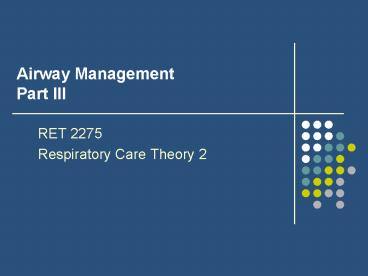Airway Management Part III - PowerPoint PPT Presentation
1 / 20
Title:
Airway Management Part III
Description:
A long-term airway placed through an incision made between the ... Laryngeal trauma or stenosis. Tracheal stenosis. Pulmonary toilet. Obstructive sleep apnea ... – PowerPoint PPT presentation
Number of Views:369
Avg rating:3.0/5.0
Title: Airway Management Part III
1
Airway ManagementPart III
- RET 2275
- Respiratory Care Theory 2
2
Tracheostomy Tubes
- A long-term airway placed through an incision
made between the 2nd and 3rd tracheal rings and
inserted directly into the trachea
3
Tracheostomy Tubes
- Indications for tracheostomy
- Airway obstruction due to the following
- Inflammatory disease
- Benign laryngeal pathology, e.g., webs, cysts,
papilloma) - Malignant laryngeal tumors
- Laryngeal trauma or stenosis
- Tracheal stenosis
- Pulmonary toilet
- Obstructive sleep apnea
4
Tracheostomy Tubes
- Advantages over prolonged translaryngeal
intubation - Eases airway care and suctioning
- Eliminates the ongoing risks of oral, nasal,
pharyngeal, and most laryngeal complications of
translaryngeal intubation - Reduces risk of tracheal extubation
- Eases tube reinsertion
- Facilitates oral communication and speech
- Improves oral, nasal, and facial hygiene
5
Tracheostomy Tubes
- Advantages over prolonged translaryngeal
intubation - Raises patient comfort level
- Improves patient appearance
- Facilitates nursing care of the overall airway
- Improves patient mobility
- Eases disposition to long-term care facility
- Less airway resistance
6
Tracheostomy Tubes
- Most experts agree that patients requiring ET
intubation for more than 7 days should have a
tracheostomy - Some evidence indicates that a tracheostomy
performed early, i.e., within 3 days of
intubation, may decrease the risk for pneumonia,
the length of mechanical ventilation, and the
length of stay in the ICU.
7
Tracheostomy Tube
- Outer Cannula primary structural unit of the
tube, to which is attached the cuff and flange - Flange prevents tube slippage into the trachea
and provides means to secure the tube to the neck - Inner Cannula cannula within the outer cannula
that can be removed for routine cleaning can be
locked in place
8
Tracheostomy Tube
- Cuff seals off the lower airway, either for
protection from aspiration or to provide positive
pressure ventilation inflation tube leads from
the cuff to a pilot balloon and spring loaded
valve Tie strings stabilizes the tube at the
stoma site - attached to the flange and is tied
around the neck
9
Tracheostomy Tube
- Obturator placed within the outer cannula with
its tip extending just beyond the far end of the
tube minimizes mucosal trauma during insertion - Radiopaque Indicator helps confirm tube position
on radiograph
10
Fenestrated Tracheostomy Tube
- The fenestrated tracheostomy tube has a removable
inner cannula. However, the outer cannula has a
hole in it a fenstration - With the inner cannula removed and the cuff
deflated, the patient may breathe through the
upper airway, via the fenestration
11
Fenestrated Tracheostomy Tube
- In the event mechanical ventilation is required,
the cuff can be inflate and inner cannula
replaced in this configuration, the tube
performs like a regular cuffed tracheostomy tube
12
Talking Tracheostomy Tube
- Provides a separate inlet for compressed gas,
which escapes above the tube allowing phonations
13
Passy-Muir Speaking Valves
14
Passy-Muir Valve
- Candidates for PMV
- Awake and alert tracheostomized (ventilator or
non-ventilator dependent patients) adult,
pediatric and neonatal
15
Passy-Muir Valve
- Benefits
- Tracheostomized and ventilator dependent patients
can produce clearer speech - Improved swallowing due to increased
pharyngeal/laryngeal sensation decreasing the
need for tube feeding - Decreased need for suctioning by enabling the
patient to produce a stronger, effective cough
16
Passy-Muir Valve
- Benefits
- Decreased aspiration due to increased
pharyngeal/laryngeal sensation - Improved weaning by improving physiologic PEEP,
which can improve oxygenation - Reduces decannulation time by allowing the
patient to begin to adjust to a more normal
breathing pattern through the upper airway - Decreased length of stay
17
Passy-Muir Valve
- Contraindications
- Unconscious and/or comatose patients
- Inflated tracheostomy tube cuff
- Foam filled cuffed tracheostomy tube
- Severe airway obstruction which may prevent
sufficient exhalation - Thick and copious secretions
- Severely reduced lung elasticity that may cause
air trapping - This device is not intended for use with
endotracheal tubes
18
Tracheostomy Button
- Used to maintain a tracheal stoma
19
Tracheostomy Button
- Fits from the skin to just inside the anterior
wall of the trachea - Avoids added resistance to the airway
- Use
- Relieving airway obstruction
- Removing secretions
- Has an adaptor for provision of IPPB or
mechanical ventilation
20
Tracheostomy Button
- Has an adaptor for provision of IPPB or
mechanical ventilation































